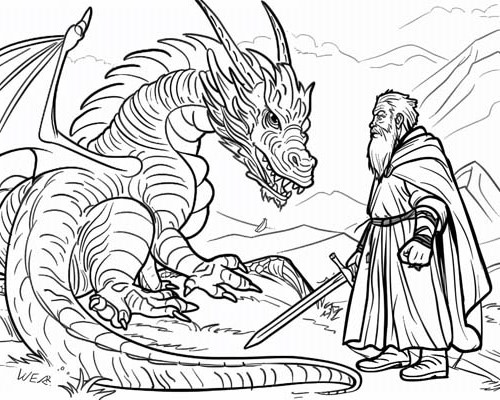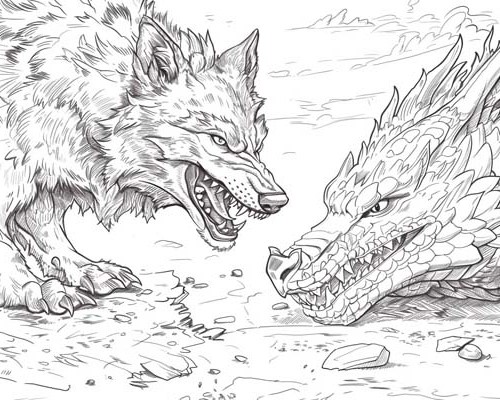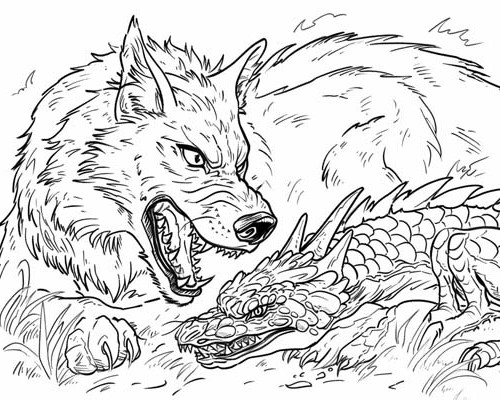Printable Coloring Pages
Welsh Dragon Coloring Pages
Welcome to our Welsh Dragon coloring pages section where you can immerse yourself in the legendary tales and timeless symbolism of one of Wales' most iconic creatures.
These coloring pages invite you to unleash your creativity as you bring to life the majestic Welsh dragon, a symbol of strength, resilience, and national pride. From fierce battles against invading forces to legendary encounters with valiant heroes, explore the rich mythology and folklore surrounding the Welsh dragon as you color scenes depicting its legendary exploits and mythical significance.
The Welsh dragon on the flag of Wales, known as "Y Ddraig Goch" in Welsh, is a powerful symbol of Welsh identity and pride. It features a striking red dragon passant (walking), with a white and green background. The dragon itself is derived from the ancient legends and mythology of Wales, where it is often associated with strength, courage, and protection.
The origins of the Welsh dragon as a symbol date back centuries, and it has been used by Welsh rulers and leaders throughout history. However, it wasn't until the 20th century that the red dragon became officially recognized as the national flag of Wales.
Owain Glyndŵr incorporated the Welsh dragon into his heraldry as a symbol of Welsh identity and resistance against English rule. The red dragon, known as "Y Ddraig Goch" in Welsh, featured prominently on Glyndŵr's coat of arms, representing his claim to the title of Prince of Wales and his aspirations for Welsh independence.
By adopting the Welsh dragon in his heraldry, Glyndŵr sought to rally support for his cause and emphasize his commitment to defending Welsh interests against English oppression. The dragon symbolized strength, courage, and national pride, serving as a powerful emblem of Welsh unity and defiance in the face of adversity.
According to legend, the Welsh dragon represents the ancient conflict between the native Britons and the invading Saxons. In Welsh mythology, the red dragon was associated with the legendary figure of Merlin, the magician, who prophesied the rise of a great Welsh leader. This leader, it was foretold, would lead the Welsh to victory over their enemies, symbolized by a white dragon, representing the Saxons or the invading forces.
In the mystical realm of Arthurian legend, Merlin the wizard is said to have foreseen a profound vision of two dragons locked in an epic battle. This vision, steeped in symbolism and prophecy, is emblematic of the eternal struggle between the forces of good and evil. One dragon, red as flame, symbolizes the native Britons, while the other, white as snow, represents the invading Saxons.
From the perspective of Wales, Merlin's vision of two dragons battling holds profound significance, weaving itself into the fabric of Welsh mythology and national identity. The red dragon, symbolizing the native Britons, resonates deeply with the Welsh people, representing their ancestral heritage, resilience, and spirit of defiance against adversity. The white dragon, representing the invading Saxons, serves as a reminder of the challenges faced by the Welsh in defending their homeland and preserving their cultural identity.
The Founding of Caerleon: According to Welsh legend, the founding of the town of Caerleon in South Wales is attributed to the actions of a fierce red dragon. The story goes that a powerful dragon was terrorizing the area, causing destruction and chaos. The local ruler, King Tewdrig, sought the help of his son, Saint Julius, who bravely confronted the dragon. After a fierce battle, Saint Julius managed to slay the dragon, saving the town from further harm. In gratitude, King Tewdrig decided to establish a new settlement at the site of the dragon's defeat, which became known as Caerleon, meaning "fortress of the lion," in honor of Saint Julius' bravery.
The Dragon of Llyn Barfog: Another Welsh legend tells of a fearsome red dragon that once inhabited the area around Llyn Barfog, a lake in Snowdonia, Wales. According to the story, the dragon would emerge from the depths of the lake to terrorize the surrounding countryside, devouring livestock and causing havoc. The dragon was said to have been defeated by a local hero named Llew Llaw Gyffes, who outwitted the beast and slew it in combat. In some versions of the tale, Llew Llaw Gyffes is aided by a magical hound, while in others, he receives help from a wise old woman. The defeat of the dragon brought peace to the region, and Llew Llaw Gyffes became celebrated as a hero for his bravery and cunning.
In the rich tapestry of Welsh folklore, the tale of the magic hound battling the Dragon of Llyn Barfog is a captivating saga that weaves together elements of bravery, cunning, and the eternal struggle between light and darkness. Set against the backdrop of the rugged Welsh landscape, this legendary encounter pits the valorous hound against the fearsome dragon in a battle of epic proportions.
The Dragon of Llyn Barfog, with its fiery breath and mighty wings, terrorized the surrounding countryside, wreaking havoc and instilling fear in the hearts of the people. It was a formidable foe, feared by all who dared to cross its path. But amidst the darkness, a beacon of hope emerged in the form of the magic hound, a creature of legend said to possess supernatural powers and unwavering courage, often depicted as a faithful companion and ally to Llew Llaw Gyffes, a Welsh hero.
As the dragon descended upon the land, the magic hound rose to meet the challenge, its fur bristling with determination and its eyes ablaze with fierce resolve. With cunning and agility, the hound engaged the dragon in a titanic struggle, each blow reverberating through the air like thunder and lightning.
In a clash of tooth and claw, fire and fury, the battle raged on, the outcome hanging in the balance. But in the end, it was the indomitable spirit of the magic hound that prevailed, driving the dragon back into the depths of Llyn Barfog and restoring peace to the land.
The tale of the magic hound's victory over the Dragon of Llyn Barfog serves as a timeless reminder of the power of courage, perseverance, and the enduring triumph of good over evil. It is a testament to the resilience of the Welsh spirit and the enduring legacy of bravery that echoes through the ages in the heart of Wales.










